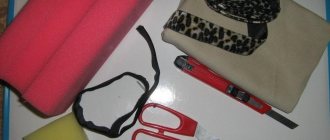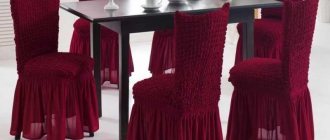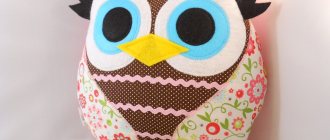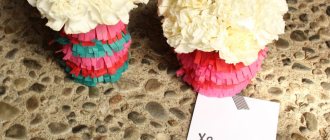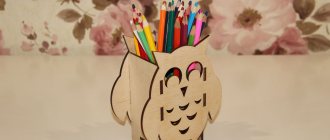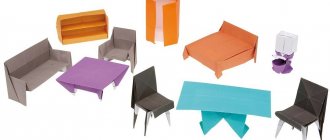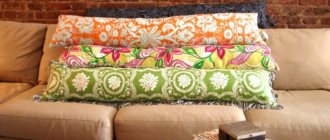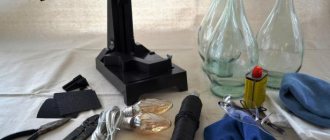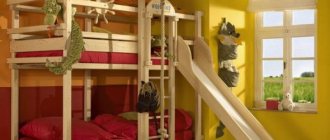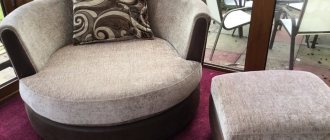Window decoration is one of the main directions in interior design. In order for the window opening to be framed into a beautiful frame of curtains, you need to know some of the subtleties of sewing. Curtains with lambrequins look romantic, which you can make yourself using patterns for beginner sewing enthusiasts. We offer interesting and educational master classes.
Kinds
There are several types of lambrequins.
Simple
This is a piece of fabric that is placed into a gather on a curtain tape. It has a simple or figured bottom edge. The first option on the curtain tape is simple, the second is swag (a hanging gathering of fabric). In order to sew the first option, you need to fold and sew the bottom and side seams, and attach a textile tape to the top edge. The bottom of the product can be decorated with an arch. It is pulled together with tape and attached to the cornice. The swag option is draped in a certain way; to do this, you need to create the correct line of folds so that the fabric is even.
Soft
For this look, light flowing fabrics are used. They drape beautifully and look soft and airy. Soft lambrequins can be combined in various ways, such as frills, bells, crossovers or swags. Ruffles, ribbons or fringes are used for decoration.
Hard
For this option you need to choose a very dense fabric. It is stretched onto a frame made of wood or glued to a non-woven base. The so-called bandeau lambrequin does not have any bends or folds; it perfectly holds its shape, which can also be of different types - round, straight, curly. For decoration you can use gold embroidery, tassels, cords or flowers.
Figured
This is a beautiful decorative element reminiscent of lace. The openwork pattern can be made using a stencil and burned using laser equipment.
Combined
The combination of hard and soft types of lambrequin allows you to create original models. As a rule, they use 3 or more drapery elements. The main condition is not to overload the design with unnecessary details.
How to choose a lambrequin taking into account the characteristics of the room?
It’s difficult, of course, to decide on the style and color of the product, but you can’t do without it. Perhaps you will find an idea in fashion magazines and add something of your own to the creation of the product. Also use the following tips:
- Thanks to lambrequins, your window can decrease in size, and the ceiling height can also become visually lower. That is why designers do not recommend hanging products of this type on windows if the ceiling height is small.
- Ideally, if the fabric product covers almost the entire height of the simple area above the window itself, then the look will be complete.
- Choose the type of product depending on the characteristic features of the room. In the spacious area of the room you can create bold design ideas. And for small rooms it is better to use ordinary textile lambrequins, which are created with a small number of folds, decorations, etc.
- When selecting materials, take into account the room in which the lambrequin will hang. Always try to choose high-quality, soft, non-wrinkly fabrics.
- If the window is on the north side, then choose light, translucent materials (organza, tulle, etc.)
- On the south side you need to hang lambrequins made of dense material. The tone of the product should match the furniture upholstery and the color of the bedspread.
- To combine the delicate shades of interior colors with curtains, it is recommended to use lambrequins in bright colors.
- It is better to create rigid lambrequins from material with patterns or embroidery. The finished product is decorated with beads, ribbons, etc.
Plain blue lambrequin
What to sew from
Fashion trends extend to both lambrequins and other textile products. So, in the new season, it is preferable to opt for materials in pastel shades with a noble texture and a simple cut. Discreet and laconic decor will advantageously emphasize the elegance of flowing curtains.
For heavy, thick curtains, the following are suitable:
- jacquard;
- linen;
- cotton;
- atlas;
- plush;
- velvet.
They will add elegance and respectability to the design of the window opening.
For light and flowing curtains, the following are preferred:
- silk;
- taffeta;
- polyester;
- organza.
They will create a feeling of airiness and add grace to the interior of the room.
It is necessary to select material for curtains and lambrequins based on the style of the living space. For the living room, you can choose noble velvet or shiny jacquard; for the bedroom, linen and satin would be an excellent solution; for the kitchen, linen, cotton and polyester are ideal. These materials are practical and beautiful, especially when choosing the Provence style.
Design options
The design of this element depends primarily on the overall design of the room. If you have a kitchen in an old classic style and the room is quite large, then you can choose a bulky design with heavy fabrics.
The noble shine of this type of fabric lifts your spirits.
If the kitchen is of a modern style, leaning toward minimalism, give preference to light and delicate fabrics and light colors. This is especially good if the kitchen is small. This solution will allow a lot of light to enter the room, and the room will become visually larger. The lambrequin itself in this case will add coziness to the room.
Lambrequins made of nylon look quite attractive.
Don’t be afraid to experiment, but remember that it’s better not to weigh down the windows in the kitchen with bulky design and dark colors. Choose a lighter, lighter design. Bright window decoration is also acceptable. In this case, use this bright color in another element of the kitchen.
Product sizing
For the lambrequin to look neat, it must match the size of the window opening.
In this case, you need to take into account the following details:
- The width of the lambrequin should be 20-25 cm longer than the rod on each side. In this case, the product will have a finished look and will provide additional protection from sunlight.
- If you need to make a folded lambrequin, then its width should be equal to the length of the cornice, increased by a factor of 1.3 to 2.
- The height of the product depends on the choice of model and your own preference. By classical standards, the lambrequin should cover 1/3 of the window and the wall above it. But if the ceilings are high, then, naturally, it is not necessary to close the partition.
Accurate calculation of the pattern will save you from various alterations.
Hard type
The technique of sewing rigid window decorations has become easier with the production of the latest self-adhesive fabric - thermoband. With it, it became possible to make excellent, perfectly created curtain designs with your own hands, having the pattern diagrams.
It is very simple to calculate the amount of material for these decorations: you need to add allowances for seam hems to the height and length of the finished frame.
Correct tailoring of this model depends on the sequence of tasks performed:
- the pattern is transferred to the adhesive fabric itself and cut exactly along the line, there is no need to add allowances;
- a similar part is cut out from the main material, taking into account the reserve;
- Using a steam iron, solder the material to the base. Soldering begins from the center of the product, this way you can avoid distortion of the pattern;
- it is advisable to decorate the edges with some kind of decorative tape;
- Attach Velcro tape to the wrong side, which will hold the frame.
Making a pattern
First, you can prepare a pattern on a small scale, and then transfer it to the fabric in the required proportions.
Lambrequin pattern with dimensions:
- For a single-section product, take a length equal to the length of the cornice.
- If the product consists of two parts, then one overlaps the other by one third.
- When choosing a three-section product, you need to perform the following calculation: the length of the rod is divided by 7 and multiplied by 3. Each section must be equal to the length of the resulting indicator. For example, the length of the cornice is 180 cm: 180:7×3=77. Each cut should be equal to 77 cm. Each element should overlap the other by 1/3.
With more elements, the folds will begin to break, and the appearance of the drapery will not be so neat.
If in the chosen model the swags do not overlap each other, then the space between them is decorated with small decorative elements - a mold (decoration from a strip of fabric cut in a spiral), ties, bells. In this way, you can hide the cords formed when the parts are pulled into folds.
Product patterns should be drawn on a wall or large table.
Using a veil
The raw materials are quite popular, which is why it is better to find out as much existing information as possible about such lambrequins for curtains with your own hands, long before starting work on the creation.
- The material is quite light and folds can be draped without any problems; it is important to correctly calculate the volume of the fabric; at this stage it is worth considering the type of curtain and how many sections it will contain.
- A simple type of product will require adding 15 to 20 cm to the length on each side. Elements with one section when created should have a value multiplied by 1.5 times.
- The pattern begins only after cutting the paper blanks, the dimensions must fully correspond to the natural size, taking into account all the small nuances it will be possible to create ideal proportions.
Step-by-step master classes
Let's look in detail at how to make lambrequins with your own hands with patterns for beginners.
Simple lambrequin
Even a beginner can handle this model.
To do this, just follow a few steps:
- Measure the length of the window opening (for example, 220 cm) and calculate the length and width of the cut.
- Cut out a strip of fabric of the required size, from 30 to 60 cm long and 3 m wide. Add 3 cm to the width of the finished fabric to finish the edge.
- Finish the panels along the edges and bottom of the product using a hem foot or do it by hand.
- Sew the fabric to the curtain tape: bend the top of the fabric to a width equal to the width of the tape plus 1 cm, and press the hem with an iron. We sew the tape on one side of the central strip of the tie, first bending it 1 cm along the edges of the lambrequin. Then we sew the tape on the other side of the tie.
At the last stage, we tighten the canvas with a cord and decorate the home interior with new clothes.
Soft
Choose an airy fabric: silk, organza or voile. The model consists of the following elements: a sagging loop (swag) and side elements (tie).
Step-by-step instruction:
- We make a drawing. We divide the length of the product into 3 parts: tie (¼ of the cut width) + swag (½ of the cut width) + tie (¼ of the cut width). The height of the lambrequin on the side is 2 times longer than the central part. Smoothly draw the bottom line of the canvas.
- We cut the fabric and form folds.
- We process the bottom with bias tape, and attach curtain tape on top. Don't forget to leave 3 cm at the edges of the fabric for processing.
Hard
You can sew a rigid lambrequin with your own hands without a pattern; to do this, you just need to accurately measure the window space. When choosing fabric, be guided by the density of the texture. Jacquard or satin will look good.
We cut and sew:
- Fabric cutting should be done according to the rules: it is important to follow the direction of the grain thread and the pattern of the material.
- When creating a pattern, do not forget to allow seam allowances.
- You can create rigidity of the fabric using dublerin; it is fixed with an iron.
- All parts of the fabric are sewn onto curtain tape.
- The bottom cut of the fabric is treated with bias tape or finishing braid.
High-quality work will decorate your home.
Children's
You can sew an elegant lambrequin for a children's room. For a girl - a lush frill; if a rigid base is used, then decor in the form of scallops, ruffles, bows, and coquelets will be suitable.
For boys, a strict simple lambrequin with a small frill is suitable.
Materials for work:
- white organza - length 4 m, width - 0.80;
- light green organza - length 4 m, width - 0.80 m;
- white and green bias tape;
- curtain braid.
You can prepare various decorative elements for decoration.
Let's get started:
- You need to prepare paper patterns. We begin to cut the white fabric at an angle of 45 degrees, like an arch, this will create beautiful coattails. The longest part will be in the middle of the cut - 0.8 m. The cut of green fabric can be done along the lengthwise lines, the length of the product at the ends is 0.8 m, in the middle - 0.4 m.
- Finish the edges with bias tape (except for the top one).
- Align the top edges of the white and green organza right sides up and stitch.
- Fold the top edge 4 cm, apply curtain tape and stitch all 3 layers of fabric.
- Pull the cord to the required width.
You can decorate the lambrequin with flowers, applique or embroidery.
With pleats
In order to make such a model, you need to take fabric 3 times longer than the length of the cornice. For example, if its length is 2.20 m, then the fabric needs 6.60 m
Instructions:
- Prepare a template.
- Cut the green chiffon 10-20 cm shorter than the pink one.
- Sew two pieces of fabric along the top edge.
- Place folds of 8-10 cm, the central fold will be a bow.
- Finish the edges with bias tape.
- Make a 5 cm hem on the wrong side and stitch along the edge.
- Attach the curtains and lambrequin to the curtain.
If desired, you can create a more complex model, as in the photo.
With ruffles
A lambrequin with ruffles can decorate any room. You can sew it from two fabrics: one is the main one, and the second is a decorative tie. You need to take as a basis the width of the canvas equal to the length of the cornice.
What you need for work:
- The fabric is yellow and white. Yellow fabric - length 4 m and width 0.45 m. White fabric: length - 2 m, width - 1 m.
- Eyelets - 11 pieces.
- Bias binding – 2 m.
Attaching to the cornice can be done in another way, not with eyelets, but with tape.
Let's get started:
- Create a pattern for yellow fabric - a rectangle 4 x 0.45 m, for white - a polygon 2 x 1 x 0.45 m. Using the pattern, cut out the details on the fabric.
- Finish the cut details along the edges with bias tape. Do not process the top cut.
- We fold the yellow and white fabrics with the front side up, the panel of white fabric should be on the side of the yellow one. Sew the parts along the top edge and finish with a zigzag stitch.
- The upper cut is bent 5 cm to the left side and stitched.
- WTO is carried out - wet heat treatment with an iron.
- Mark the eyelets, step 40 cm
- The inner circumference of the eyelet is outlined with a pencil. Using scissors, holes are made for snapping the eyelets into place.
- 11 ties are made from bias tape to support the lambrequin.
- Thread the trim pieces through the eyelets and tie them to the cornice.
When finished, straighten the folds so that there is an equal distance between them.
From strips of fabric
You can create an interesting model from strips of fabric of the same length and different widths. The length of the finished product will be 2 m.
What you need for sewing:
- 18 strips of fabric, the width of the strip is equal to the length of the cornice (take 2 m as an example).
- The length is multiplied by a factor from 1.5 to 2. Divide the resulting length by 18 - this will be the width of one strip (22.2 cm). In our work, the length of the stripes will be different. The first stripes are 1 m long, and then each subsequent strip is reduced by 10 cm.
- White fabric 8.4 m long, 22.2 cm wide.
- Beige fabric 6.4 m long, 22.2 cm wide
- Curtain tape.
The length and color of the stripes can be any, it depends on desire and imagination.
Let's get started:
- Finish the edges of the material with a hem stitch or bias tape. When cutting, do not forget to add 1.5-2 cm to the hem of the product.
- Lay out the stripes according to the diagram, put curtain tape on top, and sew all layers together using a sewing machine.
- Hang the lambrequin on the cornice. Tie the strips together.
If the strips of fabric are not rectangular in shape, then they can be applied by overlapping.
Advantages and disadvantages of homemade lambrequins
Lambrequin curtains will be an excellent decorative addition to the design of the room. A wide selection of fabrics and various patterns will allow you to realize a variety of ideas with minimal effort.
Today, the use of lambrequins in the interior is very common. They can be found in the design of bedrooms, living rooms, and children's rooms.
A self-made product is characterized by the following advantages:
- Self-production allows you to choose almost any design you desire. On the Internet you can find many different patterns and patterns that will allow you to implement even the most complex design projects. You can also purchase almost any fabric. It all depends on the finances, tastes of the apartment owner and skills. Even a beginner can sew a suitable product if he follows all the recommendations from experts.
- Externally, the products look quite unusual, so they allow you to complement the decor of the room with original and fresh ideas. You can use different fabrics and decorative inserts to add certain accents.
- Lambrequins allow you to hide possible imperfections in the cornices and ceiling from prying eyes. Based on this, you can select a suitable scheme that will allow you to optimally perform this task.
- The design of the product visually increases the space. This is an excellent solution for small apartments and rooms.
- A wide variety of styles and design options will allow you to produce a wide variety of products in accordance with your requirements.
- Price. Making curtains yourself is much cheaper than buying ready-made ones. You will become the owner of an exclusive product that no one else will have.
Note! Among the disadvantages of such a solution, some difficulties in self-tailoring should be highlighted. It can be difficult for beginners to choose the right quality fabrics and materials. That is why it is important to pay attention to the recommendations of specialists, as well as strictly follow the instructions.
Secrets of successful drapery
Curtains and drapes decorated with drapery look especially attractive. For draperies, it is better to choose fabric of solid colors. Soft delicate folds can be created from materials that drape well - cambric, silk, organza, velor.
Curtain tape is a great way to create an even fold across the entire width of the curtain, since the pleat is already built into its structure.
Using draperies made using the swag and jabot method, you can create additional decorative elements.
All these methods will help create an expressive window design and transform even the simplest curtain materials.
Curtains for the kitchen
The simplest curtains can be sewn for the kitchen . The main thing is that they are in harmony with the overall interior, that they are light, light, and “cheerful.”
The most practical material for the kitchen is polyester. Many housewives choose organza or tulle.
A fashionable novelty for decorating a kitchen window is the presence of blinds and the absence of curtains. This option is still unusual, but you can always add some zest to window decoration. Asymmetry is a great solution.
The solar curtain will fill the entire kitchen space with warmth. The easiest way to decorate a window:
- Attach the cornice.
- Cut two pieces of fabric and fold them on all sides.
- Sew loops to the top.
- Stretch a fabric of a different color from above, leaving a beautiful drapery on each side of the window.
How to decorate a window in the living room
Guests are most often invited to the living room. Where do guests' eyes go first? Of course on the window! Therefore, they try to decorate the windows in this room with beautiful curtains made of expensive fabric. Velvet is considered the most solemn and luxurious fabric.
Velvet curtains are complemented with tassels, fringe, and elegant braid.
It is best to hang velvet products in a living room, the interior of which is made in a classic style. The splendor of luxurious material will look good in a Rococo, Empire, Baroque interior, as well as next to a forged or carved wooden cornice.
How to work with velvet:
- Before cutting, carry out a wet-heat treatment to straighten the material.
- It should be cut in the direction of the pile from bottom to top so that the finished shade is deep and luxurious.
- When sewing, it is better to use silk threads.
- Make seams along the pile.
Velvet products love space, so they are hung only in a large living room. They will make a small room even smaller.
Stages of sewing an original curtain for the kitchen
See how to make a window decoration. Having mastered one type of sewing, you will be able to make all types of window decorations.
You will need:
- Main fabric;
- Fabric that acts as a lining;
- Curtain;
- One meter of cord.
Sewing instructions:
- Attach the curtain 10 cm above the window.
- Sew a cornice. Cut the main and lining fabric that will hold the folds.
- Fold the material right sides together, pin with needles, baste, stitch, leaving 35 cm at the top unstitched to turn inside out.
- Turn out, iron. Make folds.
- Fit the cornice to the curtain: center to center.
The second layer of the curtain is a cascade.
Cascade pattern.
A lambrequin made from a veil looks beautiful. Voile is a light transparent fabric that will decorate any window.
Take material of different shades and create a chic curtain.
- First, form the swag, placing it in the center.
- Then make a de jabot in a light shade (cut on the bias, complementing the swag).
- The detail for decoration is a mold, which is cut diagonally. The mold occupies the center of the structure.
How to quickly update your interior
If you are a little tired of the curtains, hang other curtains on the windows or simply make other curtains and that’s it, the interior has been successfully updated.
Folds
Curtains with folds look beautiful. You can achieve even folds using curtain tape. First, you need to attach a braid or lace to the tape, with a certain step.
Moreover, you need to do this by making precise distances to ensure uniform folds. Then stitch the tape to the panel.
If the tape is narrow, one line is enough. The wide ribbon is sewn in two lines, then you need to pull the lace and pull it off.
Buffs
It seems that it is impossible to sew a lambrequin with puffs without experience. But let's try.
- First, let's process the sections of the panel.
- Then we sew the puff tape with the top seam to the top of the fabric.
- We step back and sew on the curtain tape.
- The result was puffs in the form of a convexity.
- Let's pull the laces from the curtain tapes and get beautiful folds.
The “reaper” puffs look original.
Shell
A shell or fan is a great option for an update.
Patterns for making “shell” swag.
To give your living room a more formal look, sew curtains with fringes.
Fringe can be sewn on the bottom of the product or decorated with swags.
Braid
Curtains with braid will make the window more elegant and the atmosphere in the room - cozy.
